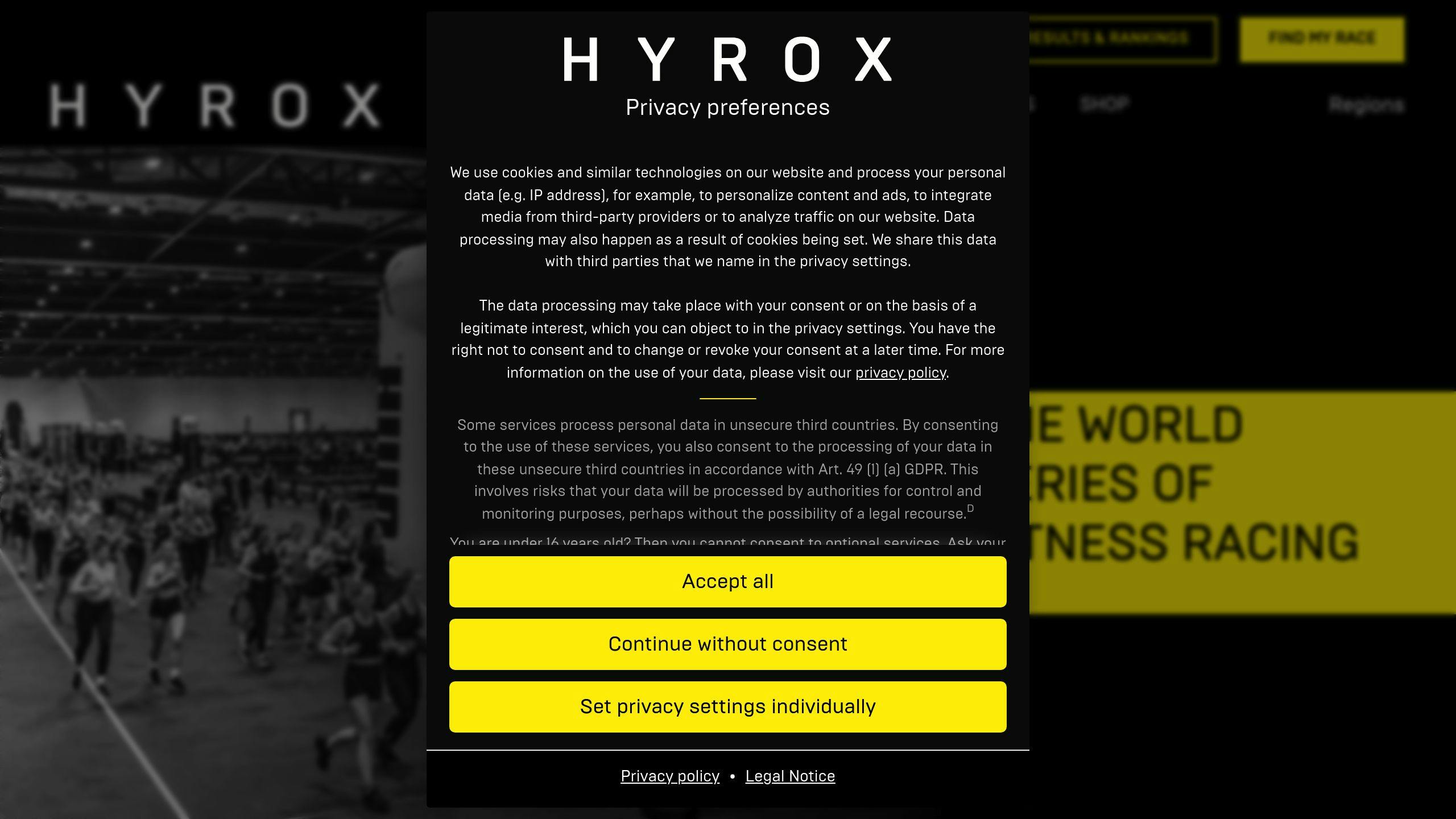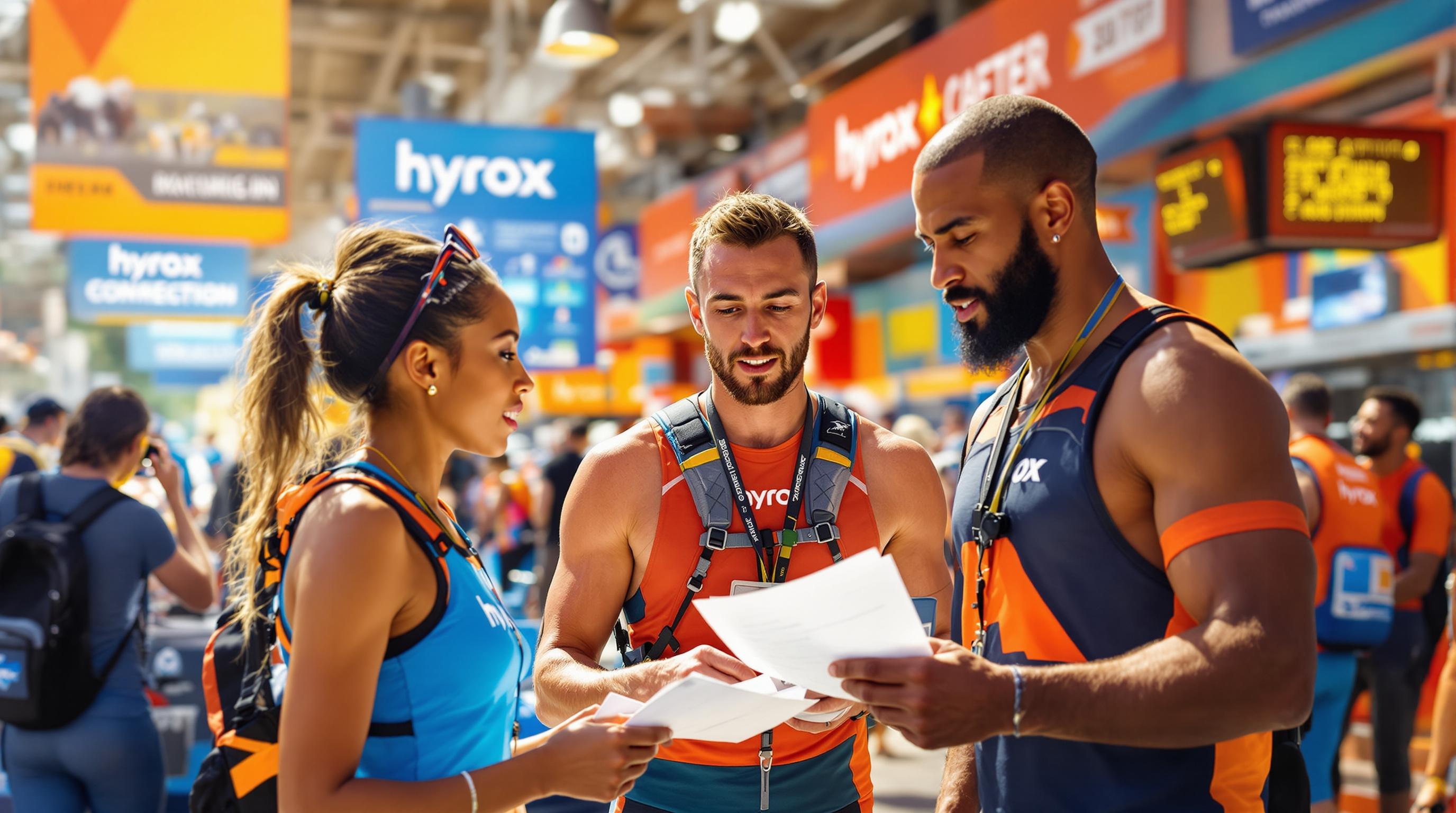Want to dominate your next HYROX race? Here's the secret: structured training periodization. This method breaks your training year into four distinct phases, helping you build endurance, strength, and stamina while avoiding burnout. Here's the breakdown:
- Off-Season (3-4 months): Build a strong fitness base with aerobic runs, strength training, and mobility work.
- Pre-Season (8-12 weeks): Transition to race-specific skills using intervals, HIIT, and HYROX-style workouts.
- Competition Phase (4-8 weeks): Fine-tune your performance with race simulations and tapering.
- Post-Season (4-6 weeks): Recover, reflect, and set goals for the next season.
Each phase targets specific goals to help you peak at the right time. Start planning your training now to maximize your performance and minimize injury risk.
HYROX Training Year Structure: Avoid These Common Mistakes!

Off-Season: Building the Foundation
The off-season, lasting about 3-4 months after your last competition, is all about laying the groundwork for better athletic performance. This period focuses on improving overall fitness and addressing weaknesses spotted in previous events through structured training.
General Physical Preparedness (GPP) Goals
During the off-season, the spotlight is on three key areas: aerobic endurance, basic strength, and movement quality. Here's how it breaks down:
- Strength Training: 2-3 sessions per week with an emphasis on compound exercises.
- Aerobic Work: 2-3 sessions per week of steady, long-distance runs (60-90 minutes).
- Circuit Training: 1-2 sessions per week featuring bodyweight exercises and core stability work.
- Recovery and Mobility: Daily focus on joint mobility and flexibility exercises.
This phase creates a solid base, helping athletes tackle specific weaknesses identified after their last season.
Pinpointing and Fixing Weak Spots
To improve, you need to dig into:
- Performance data from past races.
- Strength levels in major lifts.
- Endurance metrics.
For instance, if sled pushes were a weak point, you'd focus on strengthening your lower body and incorporating sled drills into your routine.
Sample Off-Season Training Week
Here’s an example of how you can structure your week to cover all the bases:
- Monday: Full-body strength session + 30-minute easy run.
- Tuesday: 60-90 minute aerobic run.
- Wednesday: Circuit training with bodyweight exercises.
- Thursday: Upper-body strength session + 45-minute tempo run.
- Friday: Active recovery (mobility work or swimming).
- Saturday: Lower-body strength session + moderate cardio.
- Sunday: Rest or light activity.
"The off-season is your opportunity to develop General Physical Preparedness (GPP). This 4-month period is pivotal for building a broad and stable athletic foundation that will support you throughout your HYROX training plan and competition season." - Jake Dearden, professional Hyrox athlete
Dearden suggests breaking this phase into 6-8 week blocks, gradually increasing the intensity and complexity of your workouts as part of a phased periodization approach.
Pre-Season: Transition to Hyrox-Specific Training
After building a solid fitness base during the off-season, the pre-season phase focuses on refining skills and endurance specifically for Hyrox. This 8-12 week period shifts from general fitness to race-specific preparation.
Stepping Up Workout Intensity and Volume
Training time gradually increases from 8-10 hours per week to 12-15 hours over the course of the pre-season. This progression builds on the foundation developed earlier and follows a structured overload approach:
- Weeks 1-3: 3x1km runs, 2 HIIT sessions, 3 strength sessions
- Weeks 4-6: 5x1km runs, 3 HIIT sessions, 2-3 strength sessions
- Weeks 7-9: 6-8x1km runs, 3-4 HIIT sessions, 2 strength sessions
Start at 70% of your race pace and increase intensity by 5-10% every two weeks to ensure steady progress without risking overtraining.
Adding Hyrox-Specific Workouts
To mimic race conditions, incorporate sessions that combine 1km runs with exercises like farmer's carries, sled pushes, or wall balls. These combinations help simulate the transitions you'll face during the event.
"Focus on transition efficiency between stations. The ability to switch quickly between running and functional movements often determines race success." - Lauren Weeks, Hyrox Elite Athlete and Coach
This approach targets any weaknesses identified during the off-season, ensuring a smoother flow between running and functional exercises.
Adjusting Nutrition and Recovery
As training ramps up, so do your nutritional needs. Aim for 5-7g of carbs per kilogram of body weight and 1.6-2.2g of protein per kilogram daily. Hydration is critical, with a minimum of 3-4 liters of water each day. Recovery also takes center stage, requiring:
- 8-9 hours of sleep per night
- 15-20 minutes of daily mobility work
- One full rest day per week
- Contrast therapy after workouts
These adjustments ensure your body stays fueled and ready for the demands of the competition phase.
sbb-itb-8bcd5e0
Competition Phase: Achieving Peak Performance
The competition phase is all about sharpening your race-day skills. Usually lasting 4-8 weeks before the event, this period focuses on fine-tuning your performance and preparing for race execution through targeted training.
Race-Specific Workouts and Simulations
Preparing for race day means practicing under conditions that mimic the actual event. Your training plan should include:
| Workout Type | Frequency | Purpose |
|---|---|---|
| Full Hyrox Simulation | 1x/week | Practice the entire race at 80% intensity |
| Partial Simulation | 2x/week | Focus on 2-4 stations combined with running |
| Technique Work | 2x/week | Improve form and transitions |
To get the most out of these simulations, try training at the same time your race is scheduled. This helps your body and mind adjust to the event's timing.
Tapering for Optimal Performance
In the last two weeks before the race, it's crucial to reduce training volume while keeping intensity high. This allows your body to recover while staying sharp.
Two Weeks Before the Race:
- Cut training volume by 40%
- Include 3-4 high-intensity sessions
- Focus on maintaining race pace
Race Week:
- Reduce training volume by 60%
- Do 2-3 short, high-intensity sessions
- Concentrate on refining your technique
"The competition phase is where you fine-tune your machine. It's not about building fitness anymore, but about sharpening your skills and preparing your mind for the challenge ahead." - Jake Dearden, Professional Hyrox Athlete and Coach
Mental and Logistical Race Day Preparation
Excelling in Hyrox isn't just about physical training - it requires mental readiness and solid planning. Many top athletes emphasize the importance of mental rehearsal to improve performance.
Mental Preparation Tips:
- Spend 10-15 minutes daily visualizing yourself successfully completing the race
- Use positive self-talk during tough workouts to build mental toughness
- Set specific goals for each race station to keep yourself focused
Race Day Logistics:
- Arrive at the venue 90 minutes before your start time to avoid last-minute stress
- Pack your gear the night before to ensure nothing gets left behind
For nutrition, aim to consume 7-10g of carbohydrates per kilogram of body weight in the 48 hours leading up to the event. Stick to foods you've tested during training to avoid surprises.
Post-Season: Recovery and Goal Setting
Recovery and Rest Strategies
After the intense demands of competition, the post-season is all about recovery. Top athletes like Hunter McIntyre follow a structured plan: "a full week off from training, followed by 2-3 weeks of light, varied activities before slowly ramping up to off-season training."
Here’s a simple breakdown of how to approach recovery:
| Phase | Focus Areas |
|---|---|
| Rest (7-10 days) | Prioritize sleep and gentle mobility work |
| Active (2-3 weeks) | Engage in low-impact cross-training |
| Return (2-4 weeks) | Focus on refining technique and easing back into training |
Start by improving sleep quality - aim for 8-9 hours each night, which helps with both physical recovery and mental reset. Pair this with a solid nutrition plan that includes anti-inflammatory foods and enough protein to aid muscle repair.
Evaluating Performance and Lessons Learned
Post-season is also a time to reflect on your performance. Take 10-15 minutes daily to review what worked, what didn’t, and where you can improve.
Here’s a guide to breaking it down:
| Metric | How to Analyze | What to Look For |
|---|---|---|
| Race Times | Compare splits from past events | Spot pacing trends or inconsistencies |
| Station Performance | Review competition footage | Identify areas for technical improvement |
| Training Response | Check heart rate data | Assess recovery and endurance patterns |
| Mental Resilience | Keep a self-assessment journal | Evaluate stress management and focus |
"The post-season is not just about physical recovery, but also mental rejuvenation. Use this time to reflect on your achievements, learn from your experiences, and set exciting new goals for the upcoming season." - Lauren Weeks, Hyrox World Champion
Setting Goals for the Next Season
Use this recovery period to lay the groundwork for the next season. A good approach is to set goals using the SMART framework:
- Specific Targets: Focus on station times, strength benchmarks, and technical skills that need improvement.
- Measurable Indicators: Track progress through metrics like heart rate recovery, running pace, and strength gains in key movements.
- Achievable Milestones: Build on your current performance, aiming for realistic improvements, such as a 10-15% boost in station performance.
- Time-Bound Objectives: Align your goals with a phased timeline that follows your training schedule, ensuring they directly guide your off-season priorities.
Conclusion
A well-organized periodization plan is key to excelling in Hyrox, systematically improving fitness while reducing the chance of injuries. This structure is broken into distinct phases, each tailored to meet specific seasonal goals outlined in the training framework.
The benefits of periodization in Hyrox training are clear. Athletes who stick to a structured plan consistently perform at their best when it matters most.
"Successfully tackling the HYROX season isn't about last-minute cramming; it calls for a systematic HYROX training plan that covers every aspect of your physical capabilities across the year." - Box Nutrition
Each phase targets a unique aspect of training:
| Training Phase | Primary Focus | Key Benefits |
|---|---|---|
| Off-Season | Building a Strong Base | Better general fitness, addressing weaknesses |
| Pre-Season | Sport-Specific Preparation | Improved movement efficiency, workload tolerance |
| Competition | Reaching Peak Performance | Ready for race day, top-level conditioning |
| Post-Season | Recovery and Reflection | Physical recovery, analyzing performance |
This phased plan aligns perfectly with the seasonal goals discussed earlier, offering athletes a clear, focused path for their training.
The consistent use of this four-phase system works best when tailored to an individual's progress. The post-season phase, in particular, plays a vital role in reviewing and fine-tuning strategies for the next cycle, ensuring continued improvement and success in Hyrox.
FAQs
How many times a week should I train for HYROX?
Your training schedule depends on your experience level and the phase of your training plan. Here's a breakdown of recommended sessions based on the training phase:
| Phase | Sessions | Focus |
|---|---|---|
| Off-Season | 3-4 sessions | Building general fitness, addressing weaknesses |
| Pre-Season | 4-5 sessions | Practicing HYROX-specific movements |
| Competition | 4-5 sessions | Simulating race conditions, pushing peak intensity |
| Post-Season | 2-3 sessions | Prioritizing active recovery |
This approach aligns with the gradual increase in intensity during pre-season planning.
According to the 2024 HYROX Competitor Survey, 85% of elite athletes stick to a mix of 2-3 strength sessions and 2-3 cardio sessions each week. If you're just starting, aim for 3 sessions weekly to build a solid base. More experienced athletes can manage up to 5-6 sessions.
"The key to HYROX success is consistency in training. It's better to train 3-4 times a week consistently than to overdo it and burn out." - Jake Dearden, HYROX Elite Athlete and Coach
Using a structured program can help you follow this phased approach effectively, ensuring you get the most out of each training phase.



